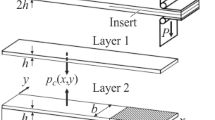Abstract
The presence of a delamination in a bi-dimensional structure causes a discontinuity in the smoothness of the mode shapes on the perimeter of the damaged area. On this basis, in this paper, a numerical method proposed by the authors for detecting discontinuities in the first derivative of a smooth piecewise function, based on a Gaussian process regression (GPR) approach, has been applied to the problem of delamination localisation in multilayered composite plates. Using the finite-element method, the mode shapes of a multilayered composite plate with a delamination are calculated and used as input data for the damage localisation procedure. The performance of the approach are analysed for different sizes and through-the-thickness positions of the damage. Furthermore the problem of ‘boundary disturbance’, the erroneous indication that a fault is present near the edge of the plate exhibited when applying the GPR approach to bi-dimensional structures, is addressed using an extrapolation procedure. The effect of noise is also investigated in order to demonstrate the effectiveness and the versatility of the method in localising delaminations.








Similar content being viewed by others
References
Voyiadjis GZ (1993) Damage in composite materials. Elsevier, Amsterdam
Doebling SW, Farrar CR, Prime MB, Shevitz DW (1996) Damage identification and health monitoring of structural and mechanical systems from changes in their vibration characteristics: a literature review. Los Alamos National Laboratory, Los Alamos, NM, Report No. LA-13070-MS
Cornwell P, Doebling SW, Farrar CR (1999) Application of the strain energy damage detection method to plate-like structures. J Sound Vib 224(2):359–374
Stubbs N, Kim JT (1996) Damage localisation in structures without baseline modal parameters. AIAA J 34:1644–1649
Ratcliffe CP (2000) A frequency and curvature based experimental method for locating damage in structures. J Vib Acoust 122:324–329
Battipede M, Ruotolo R, Surace C (2001) Damage detection of plate-like structures. Key Eng Mater 204–205:27–34
Yoon MK, Heider D, Gillespie J W, Ratcliffe CP, Crane RM (2001) Damage localisation using the two-dimensional gapped smoothing method. In: 46th international SAMPE symposium/exhibition, vol 46. Long Beach Convention Center, Long Beach, CA, pp 752–764
Yoon MK, Heider D, Gillespie JW, Ratcliffe CP, Crane RM (2005) Local damage detection using the two-dimensional gapped smoothing method. J Sound Vib 279:119–139
Thiene M, Galvanetto U, Surace C (2014) Influence of sharp stiffness variations in damage evaluation using POD and GSM. Smart Struct Syst 14(4):569–594
Gherlone M, Mattone M, Surace C, Tassotti A, Tessler A (2005) Novel vibration-based methods for detecting delamination damage in composite plate and shell laminates. Key Eng Mater 293–294:289–296
Salawu OS, Williams C (1994) Damage location using vibration mode shapes. In: Proceedings of the SPIE, 2251, proceedings of the 12th international modal analysis conference, pp 933–941
Douka E, Loutridis S, Trochidis A (2003) Crack identification in beams using wavelet analysis. Int J Solids Struct 40:3557–3569
Chang CC, Chen LW (2003) Vibration damage detection of a Timoshenko beam by spatial wavelet based approach. Appl Acoust 64:1217–1240
Chang CC, Chen LW (2005) Detection of the location and size of cracks in the multiple cracked beam by spatial wavelet based approach. Mech Syst Signal Process 19:139–155
Montanari L, Basu B, Spagnoli A, Broderick B (2015) A padding method to reduce effects for enhanced damage identification using wavelet analysis. Mech Syst Signal Process 52–53:264–277
Douka E, Loutridis S, Trochidis A (2003) Crack identification in plates using wavelet analysis. J Sound Vib 270:279–295
Surace C, Archibald R, Saxena R (2013) On the use of the polynomial annihilation edge detection for locating cracks in beam-like structures. Comput Struct 114–115:72–83
Surace C, Yan G, Archibald R, Saxena R, Feng R (2014) Crack detection using the polynomial annihilation edge detection method. Aust J Struct Eng 15(1):1–11
Surace C, Mattone M, Gherlone M (2013) Detection and localisation of structural damage based on the polynomial annihilation edge detection: an experimental verification. Key Eng Mater 569–570:1273–1280
Surace C, Saxena R, Gherlone M, Darwich H (2014) Damage localisation in plate like-structures using the two-dimensional polynomial annihilation edge detection. J Sound Vib 333(21):5412–5426
Surace C, Darwich E, Gherlone M (2013) Using the polynomial annihilation edge detection for locating delamination in laminated composite plates. In: 5th international conference on structural engineering, mechanics and computation, Cape Town, South Africa
Hensman J, Surace C, Gherlone M (2011) Detecting mode shape discontinuities without differentiation: examining a Gaussian process approach. J Phys: Conf Ser 305:1–10
Surace C, Hensman J, Mattone M, Gherlone M, Corrado N (2014) A gaussian process approach to locate cracks in plate-like structure. In: Topping BHV, Iványi P (eds) Proceedings of the twelfth international conference on computational structures technology, Civil-Comp Press, Stirlingshire, UK, paper 122. doi:10.4203/ccp.106.122
Corrado N, Gherlone M, Surace C, Hensman J, Durrande N. A new methodology for crack localisation in plates based on Gaussian process regression. Comput Struct (submitted)
O'Hagan A, Kingman JFC (1978) Curve fitting and optimal design for prediction. J R Stat Soc Ser B 40(1):1–42
Rasmussen C, Williams C (2005) Gaussian processes for machine learning (adaptive computation and machine learning). MIT Press, Cambridge
MacKay D (2003) Information theory, inference, and learning algorithms. Cambridge University Press, Cambridge
Author information
Authors and Affiliations
Corresponding author
Rights and permissions
About this article
Cite this article
Corrado, N., Gherlone, M., Surace, C. et al. Damage localisation in delaminated composite plates using a Gaussian process approach. Meccanica 50, 2537–2546 (2015). https://doi.org/10.1007/s11012-015-0193-1
Received:
Accepted:
Published:
Issue Date:
DOI: https://doi.org/10.1007/s11012-015-0193-1




